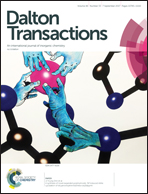Exploring the effect of hydroxylic and non-hydroxylic solvents on the reaction of [VIVO(β-diketonate)2] with 2-aminobenzoylhydrazide in aerobic and anaerobic conditions†
Abstract
Refluxing [VIVO(β-diketonate)2], namely [VIVO(acetylacetonate)2] and [VIVO(benzoylacetonate)2], separately with an equivalent or excess amount of 2-aminobenzoylhydrazide (ah) in laboratory grade (LG) CH3OH in aerobic conditions afforded non-oxidovanadium(IV) and oxidovanadium(V) complexes of the type [VIV(L1)2] (1), [VVO(L1)(OCH3)]2 (3) and [VIV(L2)2] (2), and [VVO(L2)(OCH3)] (4), respectively. (L1)2− and (L2)2− represent the dianionic forms of 2-aminobenzoylhydrazone of acetylacetone (H2L1) and benzoylacetone (H2L2), respectively, (general abbreviation, H2L), which was formed by the in situ condensation of ah with the respective coordinated [β-diketonate] in medium-to-good yield. The yield of different resulting products was dependent upon the ratio of ah to [VIVO(β-diketonate)2]. For example, the yield of 1 and 2 complexes increased significantly associated with a decrease in the amount of 3 and 4 with an increase in the molar ratio of ah. Upon replacing CH3OH by a non-hydroxylic solvent, LG CHCl3, the above reaction yielded only oxidovanadium(V) complexes of the type [VVO(L1)(OH)]2 (5), [VVO(L2)(OH)] (6) and [VV2O3(L)2] (7, 8) whereas, upon replacing CHCl3 by another non-hydroxylic solvent, namely LG CH3CN, only the respective [VV2O3(L)2] (7, 8) complex was isolated in 72–78% yield. However, upon performing the above reactions in the absence of air using dry CH3OH or dry CHCl3, only the respective [VIV(L)2] complex was obtained, suggesting that aerial oxygen was the oxidising agent and the type of pentavalent product formed was dependent upon the nature of solvent used. Complexes 3 and 4 were converted, respectively, to 7 and 8 on refluxing in LG CHCl3via the respective unstable complex 5 and 6. The DFT calculated change in internal energy (ΔE) for the reactions 2[VVO(L2)(OCH3)] + 2H2O → 2[VVO(L2)(OH)] + 2CH3OH and 2[VVO(L2)(OH)] → [VV2O3(L2)2] + H2O was, respectively, +3.61 and −7.42 kcal mol−1, suggesting that the [VVO(L2)(OH)] species was unstable and readily transformed to the stable [VV2O3(L2)2] complex. Upon one-electron reduction at an appropriate potential, each of 7 and 8 generated mixed-valence [(L)VVO–(μ-O)–OVIV(L)]− species, which showed valence-delocalisation at room temperature and localisation at 77 K. Some of the complexes showed a wide range of toxicity in a dose-dependent manner against lung cancer cells comparable with that observed with cis-platin.
![Graphical abstract: Exploring the effect of hydroxylic and non-hydroxylic solvents on the reaction of [VIVO(β-diketonate)2] with 2-aminobenzoylhydrazide in aerobic and anaerobic conditions](/en/Image/Get?imageInfo.ImageType=GA&imageInfo.ImageIdentifier.ManuscriptID=C7DT01776F&imageInfo.ImageIdentifier.Year=2017)


 Please wait while we load your content...
Please wait while we load your content...